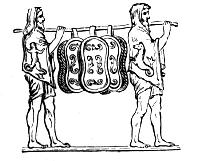This article includes a list of general references, but it lacks sufficient corresponding inline citations. (March 2013) |


The Carmen Saliare is a fragment of archaic Latin, which played a part in the rituals performed by the Salii (Salian priests, a.k.a. "leaping priests") of Ancient Rome.[1] There are 35 extant fragments of the Carmen Saliare, which can be read in Morel's FPL.[2]
The rituals revolved around Mars and Quirinus, and were performed in March and October. These involved processions in which they donned archaic armour and weapons, performed their sacred dance, and sang the Carmen Saliare. As a body they existed before the founding of the Roman Republic, tracing their origin back to the reign of Numa Pompilius. The Salian priests were chosen from the sons of patrician families whose parents were still living. They were appointed for life, though they were allowed to resign from the Salian priesthood if they achieved a more prestigious priesthood or a major magistracy.
In the Annales written by Roman historian Tacitus, it is revealed that several Romans proposed the name of Germanicus to be added to the Salian Song, as a memory of his virtue and goodwill.
- ^ Clifford Ando; Jörg Rüpke (2006). Religion and Law in Classical and Christian Rome. Franz Steiner Verlag. pp. 18–. ISBN 978-3-515-08854-1.
- ^ FPL=Fragmenta poetarum latinorum epicorum et lyricorum: praeter enni annales et Ciceronis Germanicique Aratea, originally compiled by W. Morel 1927, 2nd edition by C. Büchner 1982, 3rd and 4th editions by J. Blänsdorf in 1995 and 2011.